i made a live usb with latest kali linux version
but when i boot it up
the install screen shows up normally
but clicking install or graphical install doesn't work it just hangs in there
any ideas
but when i boot it up
the install screen shows up normally
but clicking install or graphical install doesn't work it just hangs in there
any ideas









